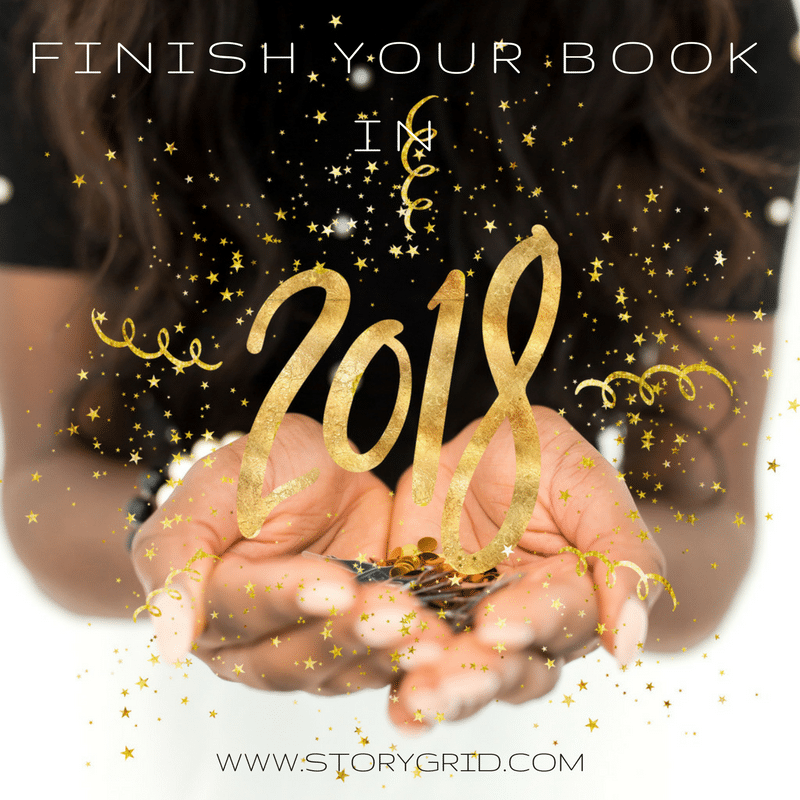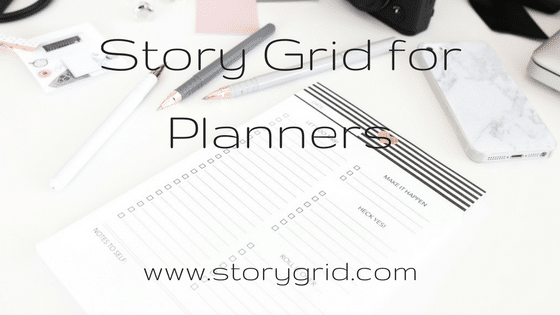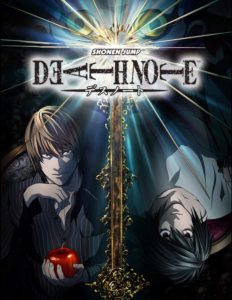It’s December 29, so it’s time to trot out all those New Year’s resolutions. Do those words send a chill down your spine? Are you thinking about the list you made last year and the year before and the year before? Do you end up recycling the usual candidates (lose-weight-get-off-social-media-save-more-money-go-to-the-gym)?
If you’re reading articles on the Story Grid website, you’re a serious writer with big dreams. Or maybe you want to be a writer, but you’re embarrassed to admit it or afraid of trying and failing.

So here’s a suggestion for a 2018 resolution: how about finishing that novel? Because that’s a goal that is 100% within your own hands, and it’s completely doable. It doesn’t rely on metabolism, your boss’s mood, or the state of the local real estate market. It’s something you can control yourself. Not only that, it’s potentially life-changing. By breaking the cycle of wishful thinking every December 31, you can reinvent yourself in a radical way. That’s something worth doing. You can finish that book this year. And Story Grid can help you do it.
You’re either a planner or a seat-of-the-pants writer
Writers tend to fall into one of two categories: planners and non-planners. There’s some crossover between the two, of course, but generally speaking, most writers either start with the germ of an idea and design a plan around it, or they start with the germ of an idea, and write forward to see what the idea is all about.
Story Grid-style planning works beautifully for both types of writers. If you’re an inveterate planner, you can use Story Grid to design a plan that will assign tasks right down to scene-level. You can assign those tasks to sessions, days, weeks, or even months, and plug away, knowing that every day you will have something specific to work on.
But Story Grid also works wonders for the writer who doesn’t know what the story is about without writing forward into it. This type of writer (I’m one) can’t come up with ideas on an outline or spreadsheet, but can spontaneously generate pages of great dialogue without thinking too hard. The problem for us is that our great dialogue sometimes wanders far afield of a workable story. That’s where Story Grid comes in—it won’t let you wander too far away from the kernel of your story, but it also won’t straightjacket you into a rigid session-by-session plan. It’s a comforting friend who will let you run off at the mouth (fingers?) while gently redirecting you as needed.
How I got my work done in 2017
Yep, I did it with Story Grid.
I’ve been writing fiction for many years. I’ve got three completely finished novels and a lot of partial projects sitting on my hard drive. But most of this dates back to the time before my kids were walking, talking, and needing me to drive them hither and yon. I decided that I was “too busy” to continue working on my fiction, and I also was demoralized by the rejection letters from New York editors who kept telling me my writing was great but my stories weren’t what they wanted. I eventually stopped writing completely.
In 2017, that all changed. I’d read the Story Grid book, listened to the podcast faithfully, and decided that I was done being a wannabe. For the first time, I felt that a New York editor was willing to explain exactly what he was looking for and how he did it—and if he was willing to write this all down for me to study and take Tim Grahl through his mental landscape in real-time on the podcast, I could use this to jump-start a brand-new writing life. I really didn’t have an excuse not to.
I’ve now revised a 144,000-word monster, and am actively writing and revising my other two manuscripts. I’ve got new projects lined up, and I’m not worried about planning them. Why? Because I feel like Story Grid has my back, and that I’m not wandering about, trying to figure out what works. I no longer have to waste my time trying to reinvent the wheel. And let’s face it, time is the most important commodity we have.
And I’m not a planner. Not at all. When I draw up plans, I end up working on the plan, not the thing itself, to the point where I have…a giant plan! The last thing I want to do is to spend many hours mulling over plans when I could spend those same hours writing. And I know that both planners and non-planners suffer from this same battle.
If you want to make 2018 the year that you actually get this book written, commit to your book now, jump in with both feet, and know that Story Grid is going to be there for you no matter what kind of writer you are.
Story Grid planning for planners

Story Grid is primarily an editing tool, designed to take apart manuscripts in a consistent, logical way. Story Grid helps to break down your story into its component pieces so that you can see where you might have left out a critical scene or where you might need to insert some action. So conversely, if you’re naturally an outliner or a planner, Story Grid can be used to plan a novel. All you do is go backwards, by starting with the pieces. Take a look at Shawn Coyne’s article here about the “math” of a novel. You can actually split a book idea into sections ahead of time and assign chapters to them. Et voila, you have an instant outline!
But maybe you’d like to create a plan with a bit more specificity, not just numbers and word count. Story Grid can help you do that, too. Use the six fundamental questions that every Story Grid editor will use to evaluate a manuscript—in fact, the most recent podcast covers this in detail here, with another episode yet to come. If you’d like to look at the technical version from the book, go to this article here.
There are ways in which Story Grid overlaps for both planners and non-planners, too. More on that below.
Story Grid planning for non-planners

Some of us need to get our hands dirty before we know what we’re doing. (In case you didn’t know, we’re called “pantsers”—because we write by the seat of our pants—nice to meet you!)
Not everyone writes in deconstructed segments, and not everyone goes into a novel knowing exactly what will happen several hundred pages down the road. In fact, just looking at a list of chapters that have yet to be written creates panic and a deer-in-headlights reaction for many writers. A few writing sessions where you stare at the blinking cursor, knowing that you are supposed to be writing an “inciting incident” for a “middle build” is enough to cause many of us to throw in the towel.
The beautiful thing about Story Grid is that Shawn Coyne has done everything for you, and all you need is to bring your genius and your diligence to the table.
The tips below are helpful for both planners and pantsers. If you find yourself getting bogged down “in the weeds” of Story Grid and feeling distraught, take a look at these suggestions and see if they help you to kick out the work. Remember, word count is what we need. Clever ideas and lots of plans alone won’t get that novel written.
Choose a genre and stick to it
What’s the best way to organize your writing ahead of time? Genre. By choosing a genre (and being strict with yourself about sticking to it, or being honest enough to change it if it ends up morphing as you write), you have the best chance of connecting with the people who will “get” your work. Go here to read Valerie Francis’ great article on genre, or you can go here to read Shawn Coyne’s disquisition on genre from the Story Grid book.
Genre is the best and easiest way to manage your reader’s expectations. My teenagers don’t read romances because they think kissing is gross. And yep, all romances have 1) kissing, or 2) a period- or culture-appropriate substitution. A first kiss (at least!) is a convention of the romance genre. So my teenagers don’t go to that part of the bookstore. They have actually abandoned books that were marketed as “adventure” because too much kissing was going on. Don’t let that happen to your books. Genre is the writer’s friend.
So step one: choose a genre. Think about the books you like to read, the movies you like to watch. What kind of story do you want to tell? Use the Story Grid graphic here to help you, but whatever you do, pick a genre and commit to it.
Keep an eye on your scenes
The building block of a novel is the scene. You need to master the scene, or you can’t write a novel.
Scenes start out with an inciting incident. Something needs to happen, something needs to start a chain reaction, or there isn’t a reason for the scene to exist. Complications then arise until there is a crisis, a climax, and then a resolution. End of scene.

Let’s do a quick-and-dirty scene analysis right here. Recently, I watched the first episode of the popular Japanese anime, Death Note. Here’s a rough breakdown of scene one:
- Inciting Incident: A notebook drops out of the sky and onto the grounds of a high school. A boy sees it fall.
- Progressive complication: The boy walks over to the notebook, opens it, sees that it is titled, “Death Note.” A sentence written on the first page states that all people whose names are written in this notebook will die. The other pages are blank.
- Crisis: Should the boy believe this? Should he take the notebook?
- Climax: The boy laughs and ridicules the notebook as nonsense. He turns his back and walks away.
- Resolution: A few minutes later, he is walking home, but the notebook is visible in a pocket of his backpack.
We probably all have a good instinct for a scene that moves forward, but this is an important skill to master. It’ll save you a lot of editing and rewriting later if your scenes all have some kind of “movement.” Every time you finish writing a scene and come up for air, check your scene to make sure it moves.
Here’s a great article by Story Grid editor Rebecca Monterusso about scenes and how they work. If you can write scenes, you can write a novel.
Both planners and non-planners need to do the math
You’re stocking a shop and your inventory is word count. You need to get it written or you can’t finish it, edit it, and publish it. So we’ll use Story Grid math to figure out what we need to produce. If you want to write an average-length novel of about 80,000 words, you can split that into a Beginning Hook of 20,000 words, a Middle Build of 40,000 words, and an Ending Payoff of 20,000 words.
Shawn Coyne recommends scenes of roughly 2,000 words, but your scenes can be longer or shorter, as long as they keep the story moving (see above). If your scenes are roughly 2,000 words long, then you’ll have ten scenes in the beginning, twenty scenes in the middle, and ten scenes at the end of the book.
How long does it take you to write a scene? If you know what you want to say, for example, does it take you an hour? Two? Three? Four? Let’s say that it takes you about an hour to type out a five hundred word scene where you know (roughly) how it starts and how it ends. You know right away that it will take you four hours to do a scene. That’s forty hours to do the Beginning Hook. If you can find five hours per week for your writing, that’s eight weeks to get through your Beginning Hook.
Don’t look at these numbers and panic. This is not meant to be a noose around your neck. However, books need words, and words need to be produced—not researched, not analyzed. Produced. You need to do whatever you can to find those hours in your life somewhere. You may need to give up television, sleep, or some of your social life. You may need to give up hobbies or cooking big meals for awhile. But you can do this. You already do lots of impressive things just living your adult life—paying bills on time, registering your car, choosing health insurance. You can absolutely handle the math of writing a novel. Evaluate it honestly and think about where you want to slot those words. Remember that research isn’t word count. Outlining isn’t word count. Only word count is word count. Just get those words out.
The Foolscap Global Story Grid: a plan for all writers

Completed Foolscap Story Grid for The Silence of the Lambs
There’s one important thing to remember about writing and analyzing. They cannot happen at the same time. You are either in “analytical head” or “creative head.”
You can search all over the ‘net and find validation of this principle, because it’s based on brain science. Here’s a quote from Shawn Coyne:
Editing is an extremely analytical, objective, left-brain skill. Writing, though, is a creative, no-holds-barred, subjective, right-brain skill. Don’t try and Edit and Write at the same time. It won’t work. If you do, you will quit in despair. No matter how much progress you think you’re making as you grind through your sentences, paragraphs, and scenes, flip-flopping between the two disciplines.
I hope you feel as relieved as I did when I realized that there was actually a scientific reason that planning exercises always prevent me from moving forward in actual word count.
Non-planners in particular struggle with this balance, because planning and creating can’t happen at the same time, so looking at an outline while writing can lead to becoming blocked.
To avoid this, focus on three things:
- Choose a genre. Make sure you know its conventions and obligatory scenes.
- Write scenes, keep an eye on “movement.” If you get lost or bored, refer to your novel’s genre and ask yourself what scenes must be in the book. A murder? A lover’s quarrel? A speech in praise of the villain? Go ahead, you’re allowed to write scenes out of order.
- Use the Foolscap Global Story Grid as your overall plan. Grab the Foolscap template here and don’t worry about the parts that you leave blank for now. (Here’s a completed Foolscap for The Silence of the Lambs if you want an exhaustive how-to manual.) Fill it in as you go, but don’t obsess on it while you write, and vice versa. Keep those two activities separate!
Every scene needs movement, and the entire book also needs movement. We Story Grid editors refer to this as the “micro” and the “macro” of the story. You don’t have to have a detailed outline in order to make sure the scenes you write are working in the big picture. Conversely, you don’t need to know all the details of the big picture in order to write.
Separate the micro and the macro movements of the story, and you’ll be productive without churning out pointless words for the sake of words. Avoid writer’s block by separating these two activities.
Story Grid editor Lori Puma wrote an excellent article explaining the difference between these two skills here. You need to do both, but not at the same time, and not necessarily ahead of time.
You can do this…a finished draft in 2018
So you’ve got a plan, whether you’re a seat-of-the-pants writer or a dedicated planner. You’ve got your Foolscap and a sense of direction and a schedule. What next?

Accountability. Make sure you get the words down!
Here are some ways to create that accountability:
- find an online writing community and upload religiously—don’t worry about quality, you can fix that later;
- find an accountability partner and trade raw work—but the rule is, no critiques;
- hire a developmental editor who will give you weekly homework and due dates for your scenes (there’s a list of Story Grid certified editors here);
- hand a friend a $100 bill (or whatever denomination makes you squirm)—s/he can keep it if you miss your next upload/accountability trade/editor assignment;
- turn off all the internet connections to your laptop and swear that you will not turn them on again until you’re ready to upload!
And what happens when you’ve finished your draft?
You can edit your own manuscript with Story Grid, you can hire a developmental editor, you can even deep-six this manuscript and start something new, using all the knowledge you’ve gained from the first experience.
Because one thing is for sure—you will be faster and better next time.
We have a tendency to create goals and to fixate on whether we “succeed” or “fail” to achieve them. As writers, we shouldn’t let go of the reality that we get better as we work. The more we do, the better the result.
And this is the biggest, and the best reason why you should commit to your novel in 2018. Not because this one is going to be the best-seller. But because finishing this novel guarantees that you not only will write a better novel more easily and efficiently next time, but that you will have transformed yourself from a writer wannabe into an author. Congratulations.